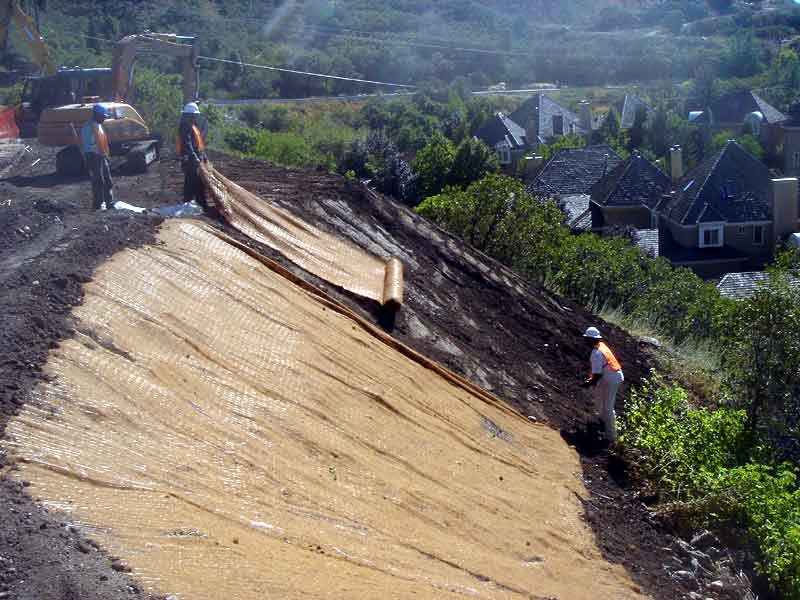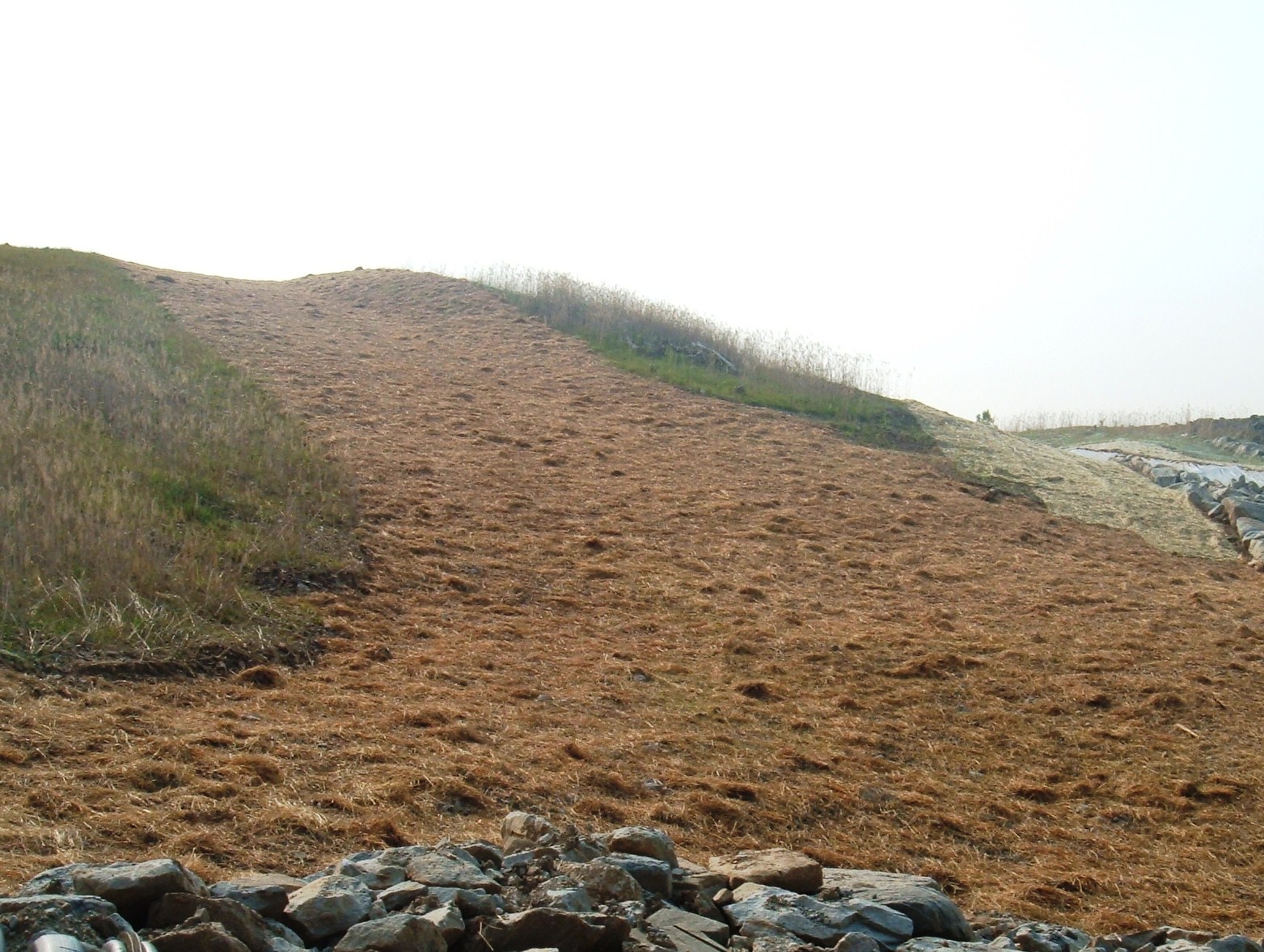Mulch and Netting

Description
Application of a protective blanket of straw or other plant residue, gravel or synthetic material to the soil surface.
Purpose
To provide immediate protection to exposed soils during the period of short construction delays, or over winter months through the application of plant residues, or other suitable materials, to exposed soil areas. Mulches also enhance plant establishment by conserving moisture and moderating soil temperatures. Mulch helps hold fertilizer, seed, and topsoil in place in the presence of wind, rain, and runoff and maintains moisture near the soil surface. In addition to stabilizing soils, mulching can reduce the speed of storm water runoff over an area.

Where Practice Applies
- In areas which have been seeded either for temporary or permanent cover, mulching should immediately follow seeding.
- Areas which cannot be seeded because of the season, or are otherwise unfavorable for plant growth.
- Mulch around plantings of trees, shrubs, or ground covers to stabilize the soil between plants.
- In an area of greater than 2:1 slope, mulching should immediately follow seeding.
Advantages
Mulching offers instant protection to exposed areas. Mulches conserve moisture and reduce the need for irrigation. Neither mulching nor matting require removal; seeds can grow through them unlike plastic coverings. This is one of the most important, effective, and economical erosion control practices.
Disadvantages/Problems
- Care must be taken to apply mulch at the specified thickness, and on steep slopes mulch must be supplemented with netting.
- Thick mulches can reduce the soil temperature, delaying seed germination.
- Mulch can be easily blown or washed away by runoff if not secured.
- Some mulch materials such as wood chips may absorb nutrients necessary for plant growth.
- Mulches such as straw, which are often applied to areas after grading must then be removed and either composted or landfilled.
Planning Considerations
- Mulches are applied to the soil surface to conserve a desirable soil property or to promote plant growth. A surface mulch is one of the most effective means of controlling runoff and erosion on disturbed land.
- Mulches can increase the infiltration rate of the soil, reduce soil moisture loss by evaporation, prevent crusting and sealing of the soil surface, modify soil temperatures, and provide a suitable microclimate for seed germination.
- Organic mulch materials, such as straw, wood chips, bark and wood fiber, have been found to be the most effective, although straw is preferred. Wood chips and bark are effective for use around trees and shrubs.
- It is important to properly anchor grass or straw mulch materials so they are not blown away by wind or washed away by flowing water. On steep slopes and critical areas such as waterways, use netting or anchoring with mulch to hold it in place.
- "Mechanical mulches" such as gravel may be used in critical areas where conditions preclude the use of vegetation for permanent stabilization.
- The choice of materials for mulching will be based on the type of soil to be protected, site conditions, season, and economics. It is especially important to mulch liberally in mid-summer and prior to winter, and at locations on cut slopes and southern slope exposures.
- Effective netting and matting require firm, continuous contact between the materials and the soil. If there is no contact, the material will not hold the soil and erosion will occur underneath the material.
Materials and Installation
| Mulch Material | Quality Standards | Application Rate / 1,000 sq. ft. | Application Rate /Acre | Depth of Application | Remarks |
| Sawdust- green or composted | Free from objectionable coarse material | 83-500 cu.ft. | --- | 1-7' | Most effective as a mulch around ornamentals, small fruits& other nursery stock. Requires 30-35 lbs. N/ton to prevent deficiency while decaying mulch. One cu. ft. weighs 25 lbs. |
| Wood Chips or Shavings | Green or airdried. Free of objectionable material | 500-900 lbs | 10-20 tons | 2-7' | Has about the same use and application as sawdust, but requires less N/ton (10-121bs}.Resistant to wind blowing. Decomposes slowly. |
| Wood Excelsior | Green or air- dried burred wood fibers | 90 lbs (one bale) | 2 tons | --- | Decomposes slowly. Subject to some wind blowing. Packaged in 80-90 lb. Bales. |
| Wood Fiber Cellulose (partially digested wood fibers) | Made from natural wood, usually with green dye & dispersing agent added | 501bs | 20001bs | --- | Apply with hydromulcher. No tie- down required. Less erosion control provided than 2t hay or straw. |
| Compost or Manure | Well shredded, free of excessive coarse materials | 400-600 lbs | 8-10 tons | --- | Use straw manure where erosion control is needed. May create problem with weeds. Excellent moisture conserver. Resistant to wind blowing. |
| Cornstalks, shredded or chopped | Airdried, shredded into 8-12' lengths | 150-300 lbs | 4-6 tons | --- | Effective for erosion control, relatively slow to decompose. Excellent for mulch on crop fields. Resistant to wind blowing. |
| Gravel, crushed stone or slag | Washed, 11/2" max. | 9 cu. yds | --- | 3' | Excellent mulch for short slopes and around woody plants and ornamentals. Frequently used over black plastic for better weed control. |
| Hay or Straw | Air-dried, free of undesirable seeds & materials | 90-100 lbs. (2-3 bales) | 2 tons (100-120 bales) | Cover about 90% of surface | Use straw where mulch is maintained for more than 3 months. Subject to wind blowing unless anchored. Most commonly used mulching material. Best microenvironment for germinating seeds. |
| Peat Moss | Dried, compressed free of coarse materials | 200-40 cu. ft | ----- | 2"-4" | Most effective as a mulch around ornamentals. Subject to wind blowing unless kept wet 100 lbs. bales (6 etLft.). excellent moisture holding capacity. |
| Jule Twisted Yam | Undyed, unbleached plain weave. Warp: 78 ends/yd. Weft. 41 ends/yd 60-90 lbs of roll | 48'x50 yds or 48'x75 yds. | --- | ---- | Use without additional mulch. Tie down as per manufacturing specification. |
| Excelsior Wood Fiber Mats | Interlocking web of excelsior fibers with photodegradable plastic netting | 48' x100'2-sided piashe;48"x180" 1-sided plastic | --- | ---- | Use without additional mulch. Excellent for seeding establishment Tie down as per manufacturers specs. Appox. 721bs/roll for Excelsior with plastic on both sides. Use 2- sided plastic for center. Plastic for centerline of waterways. |
| Glass Fiber | 1/4" thick, 7/16" dia. holes on 1" centers. 56lb rolls | 72'x30 yards | ---- | ---- | Use without additional mulch. Tie down with T-bars as per manufacturer's specifications |
| Plastic | 2-4 milks | variable | ---- | ---- | Use black for weed control. Effective moisture conservation and weed ocntrol for small fruits and ornamentals |
| Fiber Fabrics | Woven or Spun | variable | ---- | ---- | ---- |
| Straw or coconut fiber or combination | Photodegradable plastic net on one or two sides | Most are 6.5'x83.5' | 81 rolls | ---- | Designed to tolerate higher velocity flow, centerlines of waterways. 60 sq. yds. per roll. |
Mulch Anchoring Guide
| Anchoring Method or Material | Kind of Mulch to Be Anchored | How To Apply |
| Manual |
| Peg & Twine | Hay or straw | After mulching, divide areas into blocks approximately 1 sq. yd. in size. Drive 4-6 pegs per block to within 2" to 3" soil surface. Secure mulch to surface by stretching twine between pegs in criss-cross pattern on each block. Secure twine around each peg with 2 or more turns. Drive pegs flush with soil where mowing and maintenance is planned. |
| Mulch Netting | Hay or straw | Staple the light-weight paper, jute, wood fiber, or plastic nettings to soil surface according to manufacturer recommendations. Should be biodegradable. Most products not suitable for foot traffic. |
| Soil & Stone | Plastic | Plow a single furrow along edge of area to be covered with plastic, fold about 6" of plastic into the furrow and plow furrow slice back over plastic. Use stones to hold plastic down in other places as needed. |
| Cut-in | Hay or straw | Cut mulch into soil surface with square edged spade. Make cuts in contour rows spaced 18" apart. Most successful on contour in sandy soils. |
| Anchoring Method or Material | Kind of Mulch to Be Anchored | How To Apply |
| Mechanical |
| Asphalt Spray (emulsion) | Compost, wood chips, wood shavings, hay or straw | Apply with suitable spray equipment using the following rates:
Asphalt emulsion: on slopes use 200 gal/acre, on level, use 150 gal/acre
Liquid asphalt: (rapid, medium or slow setting) 0.10 gal per square yd. 400 gal/acre. |
| Wood Cellulose Fiber | Hay or straw | Apply with hydroseeder immediately after mulching. Use 750 lbs. wood fiber per acre. Some products contain an adhesive material. |
| Pick Chain | Hay or straw, manure compost | Use on slopes steeper than 3:1. Pull across slopes with suitable power equipment. |
| Mulch Anchoring tool or Disk | Hay or straw, manure/mostly straw | Apply mulch and use a mulch anchoring tool. When a disk (smooth) is used, set in straight position and pull across slope with suitable power equipment. Mulch material should be tucked into soil surface about 3". |
| Chemical | Hay or straw | Apply TerraTack AR at 120 lbs/acre in 480 gal. of water or Aerospray 70 (60 gal/acre) according to manufacturer's instructions. A 24 hr. curing period and a soil temp higher than 45 degrees F. are required. |
Common Trouble Points
- Inadequate Coverage: Results in erosion, washout, and poor plant establishment
- Appropriate tacking agent not applied, or applied in insufficient amount: Mulch is lost to wind and runoff.
- Channel grade and liner not appropriate for amount of runoff: Results in erosion of channel bottom. Plan modification may be required.
- Hydromulch applied in winter: Results in deterioration of mulch before plants can become established.
Maintenance
- Inspect after rainstorms to check for movement of mulch or erosion. If wash- out, breakage, or erosion occurs, repair surface, reseed, remulch, and install new netting.
- Straw or grass mulches that blow or wash away should be repaired promptly.
- Blanket mulch that is displaced by fl owing water should be repaired as soon as possible.
- If plastic netting is used to anchor mulch, care should be taken during initial mowings to keep the mower height high. Otherwise, the netting can wrap up on the mower blade shafts. After a period of time, the netting degrades and becomes less of a problem.
- Continue inspections until vegetation is well established.
References
Gaffney, F.B., Dickerson, J.A., Myers, R.E., Hoyt, D.K., Moonen, H.F., Smith, R.E., A Guide To: Conservation Plantings on Critical Areas for New York, U.S. Department of Agriculture, Soil Conservation Service, Syracuse, NY, June, 1991.
"Installing Erosion Control Blankets," Erosion Control, The Journal For Erosion & Sediment Control Professionals, Vol. 1, No. 4, September/October 1994.
Massachusetts Department of Environmental Protection, Office of Watershed Management, Nonpoint Source Program, Massachusetts Nonpoint Source Management Manual, Boston, Massachusetts, June, 1993.
Minnick, E. L., and H. T. Marshall, Stormwater Management and Erosion Control for Urban and Developing Areas in New Hampshire, Rockingham County Conservation District, August 1992.
North Carolina Department of Environment, Health, and Natural Resources, Erosion and Sediment Control Field Manual, Raleigh, NC, February 1991.
U. S. Environmental Protection Agency, Storm Water Management For Construction Activities, EPA-832-R-92-005, Washington, DC, September, 1992.
Washington State Department of Ecology, Stormwater Management Manual for the Puget Sound Basin, Olympia, WA, February, 1992.